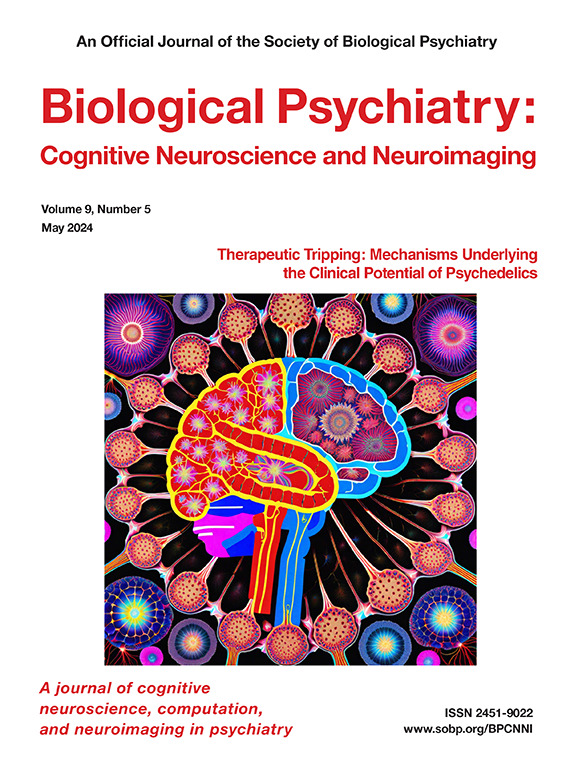Functional Magnetic Resonance Imaging–Specific Alternations in the Default Mode Network in Obsessive-Compulsive Disorder: A Voxel-Based Meta-Analysis
IF 4.8
2区 医学
Q1 NEUROSCIENCES
Biological Psychiatry-Cognitive Neuroscience and Neuroimaging
Pub Date : 2025-06-01
DOI:10.1016/j.bpsc.2024.12.001
引用次数: 0
Abstract
Background
Obsessive-compulsive disorder (OCD) is a common and debilitating mental disorder. Neuroimaging studies have highlighted that a dysfunctional default mode network (DMN) plays a key role in the pathophysiological mechanisms of OCD. However, findings of impaired DMN regions in OCD have been inconsistent. We used meta-analysis to identify functional magnetic resonance imaging (fMRI)–specific abnormalities of the DMN in OCD.
Methods
PubMed, Web of Science, and Embase were searched to screen resting-state fMRI studies of the amplitude of low-frequency fluctuation/fractional amplitude of low-frequency fluctuation (ALFF/fALFF) and regional homogeneity of the DMN in patients with OCD. Based on the activation likelihood estimation algorithm, we compared all patients with OCD and a control group in a primary meta-analysis and analyzed unmedicated OCD patients without comorbidities in secondary meta-analyses.
Results
A total of 26 eligible studies with 1219 patients with OCD (707 men) and 1238 healthy control participants (684 men) were included in the primary meta-analysis. We identified specific changes in brain regions of the DMN, mainly in the left medial frontal gyrus, bilateral superior temporal gyrus, bilateral inferior parietal lobule, bilateral precuneus, bilateral posterior cingulate cortex, and right parahippocampal gyrus.
Conclusions
Patients with OCD showed dysfunction in the DMN, including impaired local important nodal brain regions. The parietal cingulate cortex/precuneus appeared to be the most affected regions within the DMN, providing valuable insights into understanding the potential pathophysiology of OCD and targets for clinical interventions.
强迫症默认模式网络的功能磁共振成像特异性交替:基于体素的荟萃分析
背景介绍强迫症(OCD)是一种常见的使人衰弱的精神疾病。神经影像学研究强调,功能失调的默认模式网络(DMN)在强迫症的病理生理机制中起着关键作用。然而,有关 DMN 区域受损的研究结果并不一致。我们采用荟萃分析法来确定强迫症患者DMN的fMRI特异性异常:方法:检索PubMed、Web of science和Embase,筛选有关强迫症患者DMN低频波动幅度/低频波动分数幅度(ALFF/fALFF)和区域同质性(ReHo)的静息态功能磁共振成像(rs-fMRI)研究。基于活化似然估计(ALE)算法,我们在一级荟萃分析中比较了所有强迫症患者和对照组,并在二级荟萃分析中分析了无合并症的未用药强迫症患者:一级荟萃分析共纳入了 26 项符合条件的研究,包括 1219 名强迫症患者(707 名男性)和 1238 名健康对照组(684 名男性)。我们得出了DMN脑区的特定变化,主要集中在左侧额叶内侧回(MFG)、双侧颞上回(STG)、双侧顶叶下回(IPL)、双侧楔前区(PCUN)、双侧扣带回后皮层(PCC)和右侧海马旁回(PHG):结论:强迫症患者表现出DMN功能障碍,包括局部重要节点脑区受损。PCC/PCUN似乎是DMN中受影响最严重的区域,这为了解强迫症的潜在病理生理学和临床干预目标提供了宝贵的见解。
本文章由计算机程序翻译,如有差异,请以英文原文为准。
求助全文
约1分钟内获得全文
求助全文
来源期刊

Biological Psychiatry-Cognitive Neuroscience and Neuroimaging
Neuroscience-Biological Psychiatry
CiteScore
10.40
自引率
1.70%
发文量
247
审稿时长
30 days
期刊介绍:
Biological Psychiatry: Cognitive Neuroscience and Neuroimaging is an official journal of the Society for Biological Psychiatry, whose purpose is to promote excellence in scientific research and education in fields that investigate the nature, causes, mechanisms, and treatments of disorders of thought, emotion, or behavior. In accord with this mission, this peer-reviewed, rapid-publication, international journal focuses on studies using the tools and constructs of cognitive neuroscience, including the full range of non-invasive neuroimaging and human extra- and intracranial physiological recording methodologies. It publishes both basic and clinical studies, including those that incorporate genetic data, pharmacological challenges, and computational modeling approaches. The journal publishes novel results of original research which represent an important new lead or significant impact on the field. Reviews and commentaries that focus on topics of current research and interest are also encouraged.
 求助内容:
求助内容: 应助结果提醒方式:
应助结果提醒方式:


